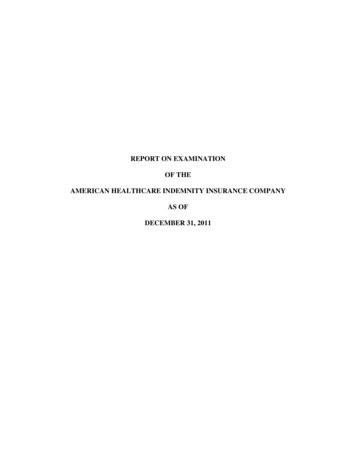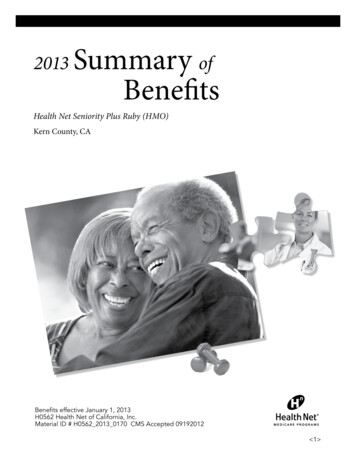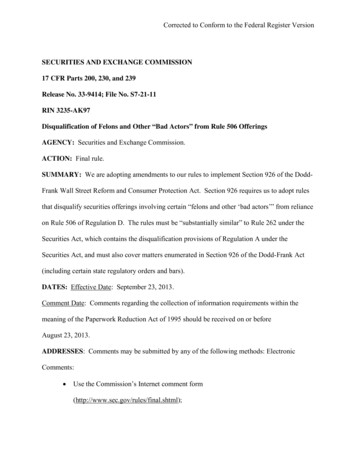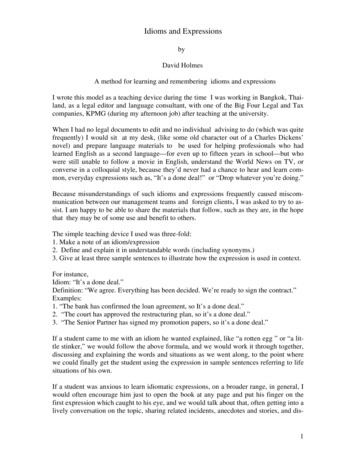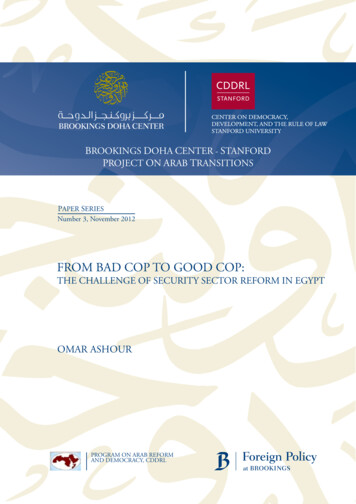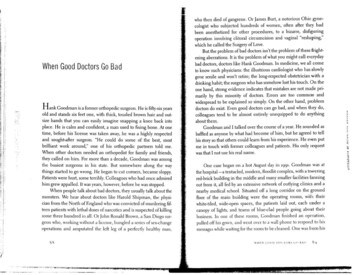
Transcription
who then died of gangrene . Or James Burt, a notorious Ohio gynecologist who subjected hundreds of women, often after they hadbeen anesthetized for other procedures, to a bizarre, disfiguringoperation involving clitoral circumcision and vaginal "reshaping,"which he called the Surgery of Love .But the problem of bad doctors isn't the problem of these frightening aberrations . It is the problem of what you might call everydaybad doctors, doctors like Hank Goodman . In medicine, we all comeWhen Good Doctors Go Badto know such physicians : the illustrious cardiologist who has slowlygone senile and won't retire ; the long-respected obstetrician with adrinking habit ; the surgeon who has somehow lost his touch . On theone hand, strong evidence indicates that mistakes are not made primarily by this minority of doctors . Errors are too common andwidespread to be explained so simply . On the other hand, problemH ankGoodman is a former orthopedic surgeon . He is fifty-six yearsdoctors do exist . Even good doctors can go bad, and when they do,old and stands six feet one, with thick, tousled brown hair and out-colleagues tend to be almost entirely unequipped to do anythingsize hands that you can easily imagine snapping a knee back intoabout them .place . He is calm and confident, a man used to fixing bone . At oneGoodman and I talked over the course of a year . He sounded astime, before his license was taken away, he was a highly respectedbaffled as anyone by what had become of him, but he agreed to telland sought-after surgeon . "He could do some of the best, mosthis story so that others could learn from his experience . He even putbrilliant work around," one of his orthopedic partners told me .me in touch with former colleagues and patients . His only requestWhen other doctors needed an orthopedist for family and friends,was that I not use his real name .they called on him . For more than a decade, Goodman was amongthe busiest surgeons in his state . But somewhere along the wayOne case began on a hot August day in lggr . Goodman was atthings started to go wrong . He began to cut corners, became sloppy .the hospital-a tentacled, modern, floodlit complex, with a toweringPatients were hurt, some terribly . Colleagues who had once admiredred-brick building in the middle and many smaller facilities fanninghim grew appalled . It was years, however, before he was stopped .out from it, all fed by an extensive network of outlying clinics and aWhen people talk about bad doctors, they usually talk about thenearby medical school . Situated off a long corridor on the groundmonsters . We hear about doctors like Harold Shipman, the physi-floor of the main building were the operating rooms, with theircian from the North of England who was convicted of murdering fif-white-tiled, wide-open spaces, the patients laid out, each under ateen patients with lethal doses of narcotics and is suspected of killingcanopy of lights, and teams of blue-clad people going about theirsome three hundred in all . Or John Ronald Brown, a San Diego sur-business . In one of these rooms, Goodman finished an operation,geon who, working without a license, bungled a series of sex-changepulled off his gown, and went over to a wall phone to respond to hisoperations and amputated the left leg of a perfectly healthy nman,messages while waiting for the room to be cleaned . One was from his88w11H'.NNcox uUO(() KScu8 AUby
iphysician assistant, at the office, half a block away . He wanted to talkto Goodman about Mrs . D .Mrs . D was twenty-eight years old, a mother of two, and the wifeof the business manager of a local auto-body shop . She had originally come to Goodman about a painless but persistent fluidswelling on her knee . He had advised surgery, and she had agreed toit . The week before, he had done an operation to remove the fluid .But now, the assistant reported, she was back ; she felt feverish and ill,and her knee was intolerably painful . On examination, he toldGoodman, the knee was red, hot, and tender . When he put a needleinto the joint, foul-smelling pus came out . What should he do?It was clear from this description that the woman was sufferingfrom a disastrous infection, that she had to have the knee opened anddrained as soon as possible . But Goodman was busy, and he neverconsidered the idea . He didn't bring her into the hospital . He didn'tgo to see her . He didn't even have a colleague see her . Send her outon oral antibiotics, he said . The assistant expressed some doubt, towhich Goodman responded, "Ah, she's just a whiner ."A week later, the patient came back, and Goodman finallydrained her knee . But it was too late . The infection had consumedthe cartilage . Her entire joint was destroyed . Later, she saw anotherorthopedist, but all he could do was fuse her knee solid to stop theconstant pain of bone rubbing against bone .When I spoke to her, she sounded remarkably philosophical ."I've adapted," she told me . With a solid knee, though, she said shecan't run, can't bend down to pick up a child . She took several fallsdown the stairs of her split-level home, and she and her family had tomove to a ranch-style house for safety's sake . She cannot sit on airplanes . In movie theaters, she has to sit sidewise on an aisle . Not longago, she went to see a doctor about getting an artificial knee, butshe was told that, because of the previous damage, it couldn't safelybe done .Every physician is capable of making a dumb, cavalier decisionlike Goodman's, but in his last few years of practice he made themgo( ()IPI ICAT10N',over and over again . In one case, he put the wrong-size screw into apatient's broken ankle, and didn't notice that the screw had gone intoo deep . When the patient complained of pain, Goodman refusedto admit that anything needed to be done . In a similar case, he put awrong-size screw into a broken elbow . The patient came back whenthe screw head had eroded through the skin . Goodman could easilyhave cut the screw to size, but he did nothing .Another case involved an elderly man who'd come in with a broken hip . It looked as if he would need only a few pins to repair thefracture . In the operating room, however, the hip wouldn't cometogether properly . Goodman told me that he should have changedcourse and done a total hip replacement . But it had already been astrenuous day, and he couldn't endure the prospect of a longer operation . He made do with pins . The hip later fell apart and becameinfected . Each time the man came in, Goodman insisted there wasnothing to be done . In time, the bone almost completely dissolved .Finally, the patient went to one of Goodman's colleagues for a second opinion . The colleague was horrified by what he found . "Heignored this patient's pleas for help," the surgeon told me . "He justwouldn't do anything . He literally wouldn't bring the patient intothe hospital . He ignored the obvious on X rays . He could have killedthis guy the way things were going ."For the last several years that Goodman was in practice, he wasthe defendant in a stream of malpractice suits, each of which hesettled as quickly as he could . His botched cases became a staple ofhis department's Morbidity and Mortality conferences .Sitting with him over breakfast in a corner of a downtown restaurant, I asked him how all this could have happened . Words seemedto elude him . "I don't know," he said faintly.Goodman grew up in a small northwestern town, the secondchild of five in an electrical contractor's family, and neither he noranyone else ever imagined that he might become a doctor . Incollege, a local state university, he was at first an aimless, mediocreWh EN (;o01) DOG I ORS GO BAD9l
student . Then one night he was up late drinking coffee, smoking cigarettes, and taking notes for a paper on a Henry James novel when itcame to him : "I said to myself, 'You know, I think I'll go into medicine ."' It was not exactly an inspiration, he said . "I just came to adecision without much foundation I could ever see ." A minister oncetold him that it sounded "more like a call than I ever got ."Goodman became a dedicated student, got into an excellentmedical school, and headed for a career in surgery after graduation .After completing military duty as a general medical officer in the AirForce, he was accepted into one of the top orthopedics-residencyprograms in the country. He found the work deeply satisfying, despitethe gruelling hours . He was good at it . People came in with intenselypainful, disabling conditions -dislocated joints, fractured hips,limbs, spines-and he fixed them . "Those were the four best years ofmy life," he said . Afterward, he did some subspecialty training inhand surgery, and when he finished, in 1978, he had a wide range ofchoices for work . He ended up back in the Northwest, where hewould spend the next fifteen years ."When he came to the clinic here, we had three older, rusty andcrusty orthopedic surgeons," a pediatrics colleague of his told me ."They were out of date and out of touch, and they weren't very niceto people . Then here comes this fellow, who's a sweetheart of a guy,more up to date, and he doesn't say no to anybody . You call him ateight o'clock at night with a kid who needs his hip tapped because ofinfection, and he'll come in and do it-and he's not even the oneon call ." He won a teaching award from his medical students . Heattracted a phenomenal amount of business . He reveled in the job .Sometime around 19go, however, things changed . With his skilland experience, Goodman knew better than most what needed to bedone for Mrs . D, for the man with the shattered hip, and for manyother patients, but he did not do it . What happened? All he could tellme was that everything seemed wrong those last few years . He usedto enjoy being in the operating room, fixing people . After a while,(2 :(.)MiPL!CArIVNsthough, it seemed that the only thing he thought about was gettingthrough all his patients as quickly as possible .Was money part of the problem? He made about two hundredthousand dollars a year at first, and the more patients he saw and themore cases he took the more money he made . Pushing himself, hefound that he could make three hundred thousand dollars . Pushinghimself even harder, until he was handling a dizzying number ofcases, he made four hundred thousand dollars . He was far busierthan any of his partners, and that fact increasingly became, in hismind, a key measure of his worth . He began to call himself, only halfin jest, "The Producer ." More than one colleague mentioned to methat he had become fixated on his status as the No . i booker .His sense of himself as a professional also made him unwillingto turn people away . (He was, after all, the guy who never said no .)Whatever the cause, his caseload had clearly become overwhelming .He'd been working eighty, ninety, a hundred hours a week for wellover a decade . He had a wife and three children-the children aregrown now-but he didn't see much of them . His schedule waspacked tight, and he needed absolute efficiency to get through it all .He'd begin with, say, a total hip replacement at 7 :30 A .M . and try tofinish in two hours or so . Then he'd pull off his gown, tear throughthe paperwork, and, as the room was being cleaned, stride out themain tower doors, into the sun, or snow, or rain, over to the outpatientsurgery unit, half a block away . He'd have another patient waiting onthe table there - a simple case, maybe a knee arthroscopy or a carpaltunnel release . Near the end, he'd signal a nurse to call ahead andhave the next patient wheeled into the OR back in the main tower .He'd close skin on the second case and then bolt back for a third .He went back and forth all day . Yet, no matter what he did to keepup, unforeseen difficulties arose-a delay in getting a room ready, anew patient in the emergency room, an unexpected problem in anoperation . Over time, he came to find the snags unbearable . That'sundoubtedly when things became dangerous . Medicine requires thek iu .N :uui 00CIORS 1 ;1 HAI)93
fortitude to take what comes : your schedule may be packed, the hourranging from a family physician with a barbiturate addiction to alate, your child waiting for you to pick him up after swimming prac-fifty-three-year-old cardiac surgeon who continued operating despitetice ; but if a problem arises you have to do what is necessary . Timepermanent cerebral damage from a stroke . And nearly everywhereafter time, Goodman failed to do so .she looked she found the same thing . It was a matter of months, evenyears, before colleagues took effective action against a bad doctor,This sort of burnout is surprisingly common . Doctors are sup-however dangerous his or her conduct might have been .posed to be tougher, steadier, better able to handle pressure thanPeople have called this a conspiracy of silence, but Rosenthalmost . (Don't the rigors of medical training weed out the weak ones?)did not find plotting so much as a sorry lack of it . In the communitiesBut the evidence suggests otherwise . Studies show, for example, thatshe has observed, the dominant reaction was uncertainty, denial,alcoholism is no less common among doctors than among otherand dithering, feckless intervention-very much like a family thatpeople . Doctors are more likely to become addicted to prescriptionwon't face up to the fact that grandma needs to have her driver'snarcotics and tranquilizers, presumably because we have such easylicense taken away. For one thing, not all problems are obvious : col-access to them . Some 32 percent of the general working-age popula-leagues may suspect that Dr . So-and-So drinks too much or hastion develops at least one serious mental disorder-such as majorbecome "too old," but certainty about such matters can remain elu-depression, mania, panic disorder, psychosis, or addiction-andsive for a long time . Morever, even when problemsthere is no evidence that such disorders are any less common amongleagues often find themselves unable to do anything decisive .are obvious,col-doctors . And, of course, doctors become ill, old, and disaffected, orThere are both honorable and dishonorable reasons for this .distracted by their own difficulties, and for these and similar reasonsThe dishonorable reason is that doing nothing is easy . It takes anthey falter in their care of patients . We'd all like to think of "problemenormous amount of work and self-assurance for colleagues to gatherdoctors" as aberrations . The aberration may be a doctor who makes itthe evidence and the votes that are needed to suspend another doc-through a forty-year career without at least a troubled year or two .tor's privileges to practice . The honorable reason, and probably theNot everyone with "problems" is necessarily dangerous, of course .main reason, is that no one really has the heart for it . When a skilled,Nonetheless, estimates are that, at any given time, 3 to 5 percent ofdecent, ordinarily conscientious colleague, whom you've known andpracticing physicians are actually unfit to see patients .worked with for years, starts popping Percodans, or becomes pre-There's an official line about how the medical profession is sup-occupied with personal problems, and neglects the proper care ofposed to deal with these physicians : colleagues are expected to joinpatients, you want to help, not destroy the doctor's career . There isforces promptly to remove them from practice and report them tono easy way to help, though . In private practice, there are no sabbati-the medical-licensing authorities, who, in turn, are supposed to disci-cals to offer, no leaves of absence, only disciplinary proceedings andpline them or expel them from the profession . It hardly ever happenspublic reports of misdeeds . As a consequence, when people try tothat way . For no tight-knit community can function that way .help, they do it quietly, privately . Their intentions are good ; theMarilynn Rosenthal, a sociologist at the University of Michigan,result usually isn't .has examined how medical communities in the United States, GreatBritain, and Sweden deal with problem physicians . She has gatheredFor a long time, Hank Goodman's colleagues tried to help him .data on what happened in more than two hundred specific cases,Starting around rygo, they began to have suspicions . There was talky4(ON-ll'1 .I( :AIIONS\VI-IFfN 0001) 1)OC'I'ORS CO BAD95
of the bizarre decisions, the dubious outcomes, the growing numberlevel operations to make sure a particular surgeon doesn't do any-of lawsuits . More and more, people felt the need to step in .thing harmful .A few of the older physicians, each acting on his own, took himOne of Goodman's physician assistants tried to take on this pro-aside at one point or another . Rosenthal calls this the Terribly Quiettective role . When he first began working with Goodman-helpingChat . A partner would see Goodman at a cocktail party or just hap-to set fractures, following patients' progress, and assisting in the oper-pen to drop by his home . He'd pull Goodman aside, ask how he wasating room-he revered the man . But he noticed when Goodmandoing, tell him that people had concerns . Another took the tough-became erratic . "He'd run through forty patients in a day and notlove approach : "I said to him straight out, I don't know what makesspend five minutes with them," the assistant told me . To avert prob-you tick . Your behavior is totally bizarre . The scary thing is Ilems in the clinic, he stayed late after hours, double-checkingwouldn't let my family members go near you ."'Goodman's decisions . "I was constantly following up with patientsSometimes this approach can work . I spoke to a retired depart-and changing what he did for them ." In the operating room, he triedment head at Harvard who had initiated more than a few Terriblyto make gentle suggestions . "Is that screw too long?" he might ask .Quiet Chats in his time . A senior physician can have forbidding moral"Does the alignment on that hip look right?" There were nonethe-authority in medicine . Many wayward doctors whom the departmentless mistakes and "a lot of unnecessary surgery," he said . When hehead confronted confessed to having troubles, and he did what hecould, he steered patients away from Goodman-"though withoutcould to assist . He'd arrange to have them see a psychiatrist, or go to aactually coming out and saying, I think he's crazy ."'drug rehab center, or retire . But some doctors didn't follow through .Matters can drift along this way for an unconscionably longOthers denied that anything was wrong . A few went so far as to mounttime . But when someone has exhausted all reservoirs of goodwill-small campaigns in their defense . They would have family memberswhen the Terribly Quiet Chats are clearly going nowhere and therecall him in outrage, loyal colleagues stop him in the hospital halls toseems to be no end to the behind-the-scenes work colleagues have tosay they'd never seen any wrongdoing, lawyers threaten to sue .do-the mood can change swiftly . The smallest matter can precipi-Goodman did listen to what people had to say . He nodded andtate drastic action . With Goodman, it was skipping the mandatoryconfessed that he felt overworked, at times overwhelmed . He vowedweekly Morbidity and Mortality conferences, which he started to doto make changes, to accept fewer cases and stop rushing throughthem, to perform surgery as he knew it should be performed . Hein late 1993 . As negligent as his patient care could be-he hadbecome one of the hospital's most frequently sued doctors-peoplewould walk away mortified, resolving to mend his ways . But in theremained uncomfortable about judging him . When Goodmanend nothing changed .stopped attending M & Ms, however, his colleagues finally had aAs is often the case, the people who were in the best position toconcrete violation to confront him with .see how dangerous Goodman had become were in the worst posi-Various people warned him, with increasing sharpness, that hetion to do anything about it : junior physicians, nurses, ancillary staff .would be in serious trouble if he didn't start showing up at M & Ms .In such circumstances, the support staff will often take measures to"But he ignored them all," a colleague of his told me . After a year ofprotect patients . Nurses find themselves quietly directing patients tothis, the hospital board put him on probation . Through it all, he wasother doctors . Receptionists suddenly have trouble finding openingsoperating on more patients and generating ever more complications .in a doctor's schedule . Senior surgical residents scrub in on junior-Another whole year went by . Soon after Labor Day of 1995, the boardq6COMPLICAPIONSWHLN GOOD DO( IONS GO BAD97
and its lawyer finally sat him down at the end of a long conferencetable and told him that they were suspending his operating privilegesand referring his conduct to the state medical board for investigation . He was fired .Goodman had never let on to his family about his difficulties,and he didn't tell them that he'd lost his job . Each morning forweeks, he put on a suit and tie and went to his office, as if nothinghad changed . He saw the last of his scheduled patients, and referredthose who needed an operation to others . His practice dried upwithin a month . His wife sensed that something was wrong, andwhen she pressed him, he finally told her . She was floored, andfrightened : she felt as if he were a stranger, an impostor . After that,he just stayed home in bed . He spoke to no one for days at a time .Two months after his suspension, Goodman was notified ofanother malpractice suit, this one on behalf of a farmer's wife whohad come to him with a severely arthritic shoulder . He had put in anartificial joint, but the repair failed . The lawsuit was the last straw . "Ihad nothing," he told me . "I had friends and family, yes, but no job ."told us, he had taken charge of a small program to help hospitals andmedical groups with troubled doctors . Before long, they were sending him doctors from all over . To date, he'd seen more than two hundred and fifty, a remarkable wealth of experience, and he wentthrough the data he'd collected like a CDC scientist analyzing anoutbreak of tuberculosis .What he found was unsurprising . The doctors were often notrecognized to be dangerous until they had done considerable damage . They were rarely given a thorough evaluation for addiction,mental illness, or other typical afflictions . And, when problems wereidentified, the follow-through was abysmal . What impressed me wasNeff's single-handed, quixotic attempt-he had no grants, no assistance from government agencies-to do something about this .A few months after the lecture, I flew to Minneapolis to see Neffin action . His program was at Abbott Northwestern Hospital, nearthe city's Powderhorn district . When I arrived, I was directed to thefifth floor of a brick building discreetly off to one side of the mainhospital complex . There I found a long, dimly lit hallway withAs with many doctors, his job was his identity .In his basement den, he had a gun, a .44 Magnum that he hadbought for a fishing trip to Alaska, to protect him against bears . Hefound the bullets for the gun and contemplated suicide . He knewhow to do it so that his death would be instantaneous . He was, afterall, a surgeon .closed, unmarked doors on both sides and beige, low-pile carpeting . It looked nothing like a hospital . A block-lettered sign read"Professional Assessment Program ." Neff, in a tweed jacket andIn 1998, I was at a medical conference near Palm Springs, skimming through the dense lecture schedule, when an unusual presentation caught my eye : "Two Hundred Physicians Reported forstyle rooms where they would stay for four days and four nights .Three doctor-patients were staying during the week that I visited .They were permitted to come and go as they pleased, Neff assuredme . Yet I knew that they were not quite free . In most cases, their hos-Disruptive Behavior," by Kent Neff, M .D . The lecture was in a smallclassroom away from the main lecture hall . At most, a few dozenpeople attended . Neff was fiftyish, trim, silver-haired, and earnest,and he turned out to have what must be the most closeted subspecialty in medicine : he was a psychiatrist specializing in doctors andother professionals with serious behavioral problems . In 1994, he98CONIN,ICAIIONSmetal-rimmed glasses, came out of one of the doors and showed mearound .Each Sunday night, the physicians arrived here, suitcases inhand . They checked in down the hall and were shown to dormitory-pitals had paid the program's fee of seven thousand dollars and toldthe doctors that if they wanted to keep their practices they had to goto Minneapolis .The most striking aspect of the program, it seemed to me, wasthat Neff had actually persuaded medical organizations to send the\VIILN COO1) 1)Of'IORS GO IIAI)99
doctors . He had done this, it seemed, by simply offering to help . Fortion about someone's chest pains . He examined the person sent toall their dithering, hospitals and clinics turned out to be eager forhim, performed some tests, and gave a formal opinion about whatNeff's assistance . And they weren't the only ones . Before long, airlines began sending him pilots . Courts sent him judges . Companieswas going on, about whether the person could safely be kept on thesent him CEOs .to do what everyone else was extremely reluctant to do : to judge (or,job, and about how things might be turned around . Neff was willingA small part of what Neff did was just meddle . He was like one ofas he prefers to say, to "assess") a fellow doctor . And he did it morethose doctors whom you consult about a coughing child, and whothoroughly and dispassionately than a doctor's colleagues ever could .then tell you how to run your life . He'd take the doctors in hand, butNeff's first step with the three doctors seeing him the week I washe was not shy about telling organizations when they had let a prob-there was to gather information . Starting on Monday morning, andlem fester too long . There are certain kinds of behavior-what hethroughout the next two days, he and four clinicians separately inter-calls "behavioral sentinel events"-that should alert people thatviewed each of the doctors . They were made to tell their stories oversomething may be seriously wrong with a person, he explains . Forand over again, half a dozen times or more, in order to break throughexample, a surgeon throws scalpels in the OR, or a pilot bursts intotheir evasions and natural defensiveness, and to bring out the details .uncontrolled rages in midflight . Yet, in case after case, such episodesare shrugged off. "He's a fine doctor," people will say, "but some-Before they arrived, Neff had also put together a thick dossier ontimes he has his moments ."colleagues back home in order to sort through the contradictionsNeff recognizes at least four types of behavioral sentinel events .each of them . And during the week he did not hesitate to call theirand ambiguities in their versions of events .There is persistent, poor anger control or abusive behavior . There isNeff's patients also underwent a full exam, including bloodbizarre or erratic behavior . (He saw a doctor who could not getwork, to make sure that no physical illness could account for anythrough the day without spending a couple of hours arranging anddangerous behavior . (One doctor, who was sent to Neff after severalrearranging his desk . The doctor was found to have severe obsessive-episodes of freezing in place in mid-operation, was found to havecompulsive disorder .) There is transgression of proper professionaladvanced Parkinson's disease .) They were given alcohol and drugboundaries . (Neff once saw a family physician who was known totesting . And they underwent psychological tests for everything fromtake young male patients out alone for dinner and, in one instance,gambling addiction to paranoid schizophrenia .on vacation with hire . He turned out to have compulsive fantasies ofOn the last day, Neff assembled his team around a conferencesex with pubescent boys .) And there is the more familiar marker oftable in a drab little room to make their determinations . Meanwhile,incurring a disproportionate number of lawsuits or complaints (asthe physicians waited in their rooms . The staff members spent aboutGoodman had) . Through his program, Neff has persuaded a sub-an hour reviewing the data in each case . Then, as a team, they madestantial number of hospitals and clinics-and airlines and corpora-three separate decisions . First, they arrived at a diagnosis . Most doc-tions-to take such events seriously . Many organizations have nowtors turned out to have a psychiatric illness-depression, bipolar dis-specified, as a part of their contracts, that behavioral sentinel eventsorder, drug or alcohol addiction, even outright psychosis . Almostcould trigger an evaluation .without exception, the condition had never been diagnosed orThe essence of what he did, however, was simply to provide atreated . Others were simply struggling with stress, divorce, grief, ill-patient consultation, the way a cardiologist might provide a consulta-ness, or the like . Next, the team decided whether the doctor was fit to100COMPLICATIONSWill'-A GOUI) I)O( :TORCcoSWIC)1I
return to practice . Neff showed me some typical reports . The judgment was always clear, unequivocal : "Due to his alcoholism, Dr . Xcannot practice with reasonable skill and safety at this time ." Last,they spelled out specific recommendations for the doctor to follow.For some doctors deemed fit to return to practice, they recommended certain precautions : ongoing random drug testing, formalmonitoring by designated colleagues, special restrictions on the doctor's practice . For those found unfit, Neff and his team
one hand, strong evidence indicates that mistakes are not made pri-marily by this minority of doctors . Errors are too common and widespread to be explained so simply. On the other hand, problem doctors do exist. Even good doctors can go bad, and when they do, colleagues tend to

